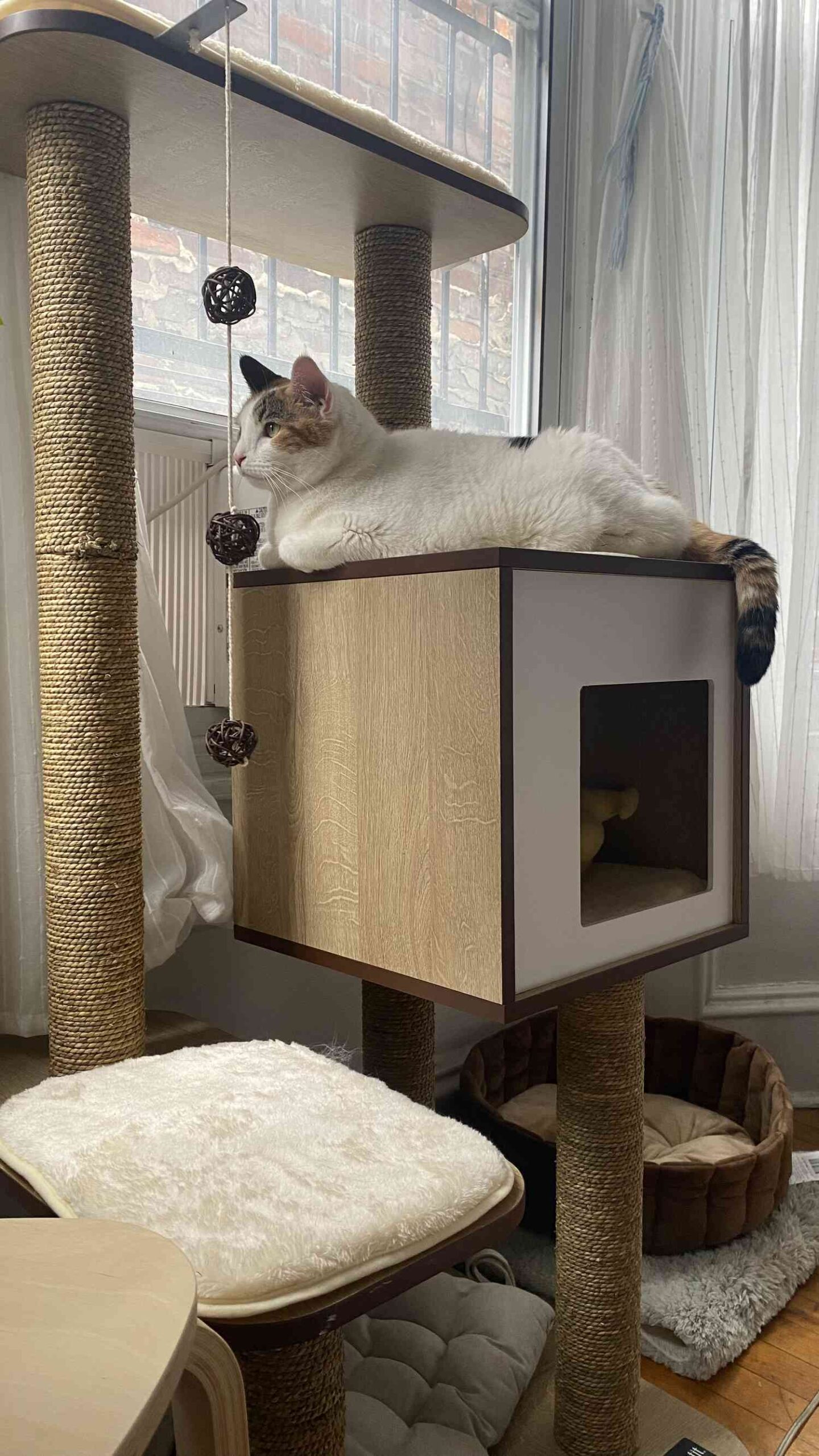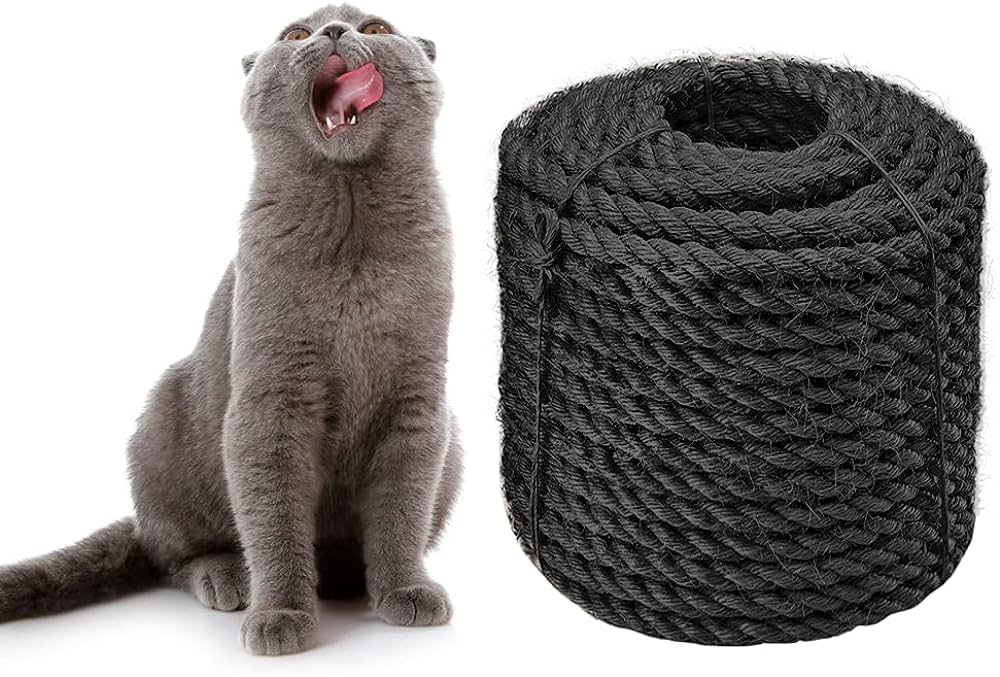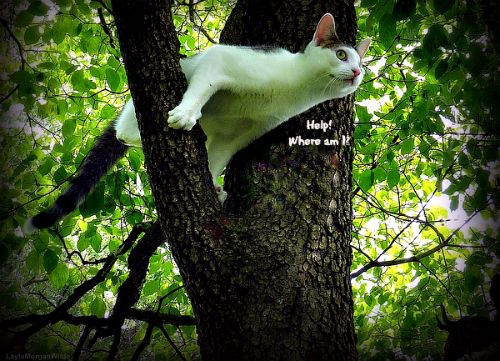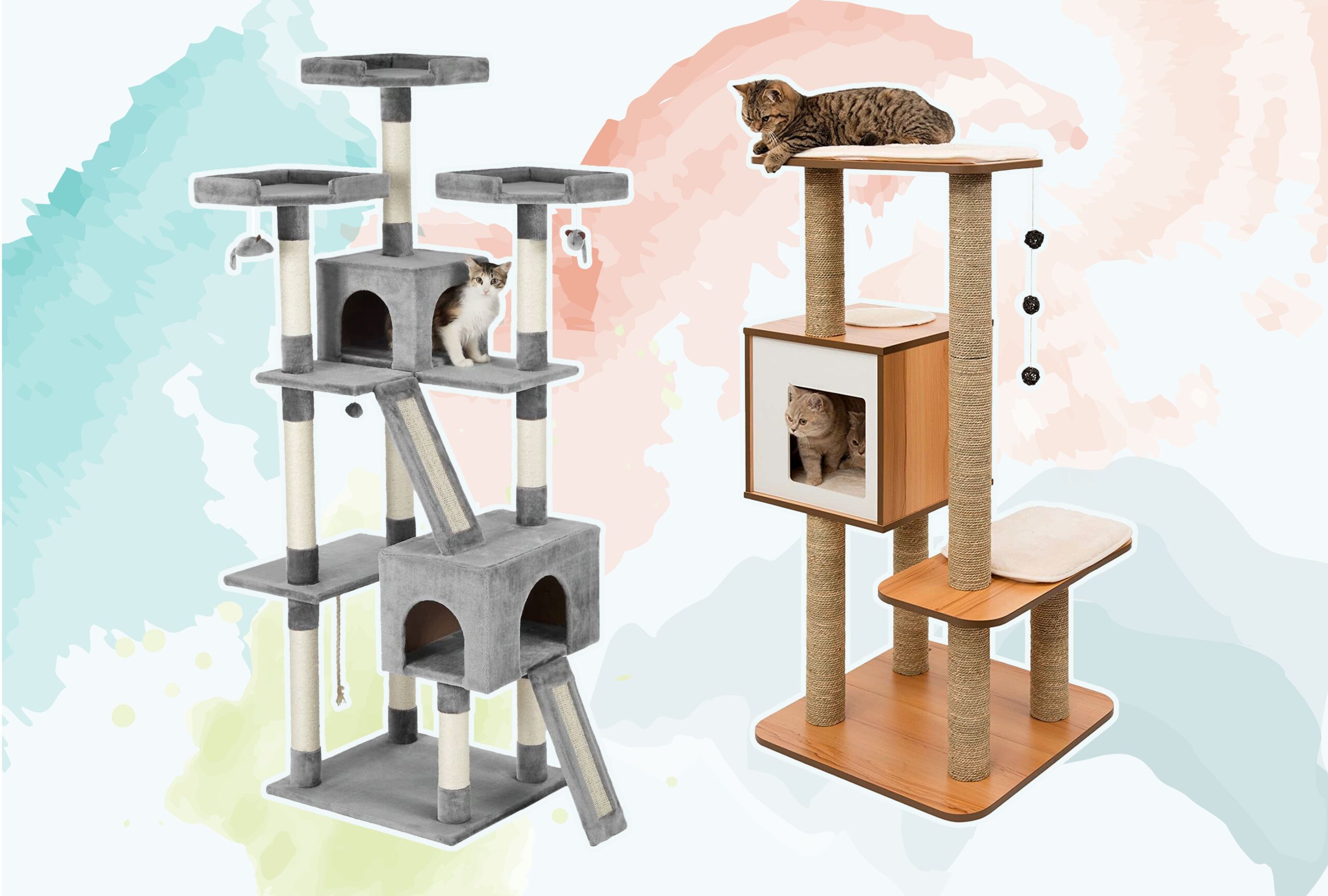To stop a cat tree from wobbling, secure it tightly to a wall and ensure its base is stable. Check for loose screws or parts and tighten them.
Cat trees are essential for your feline friend’s exercise and enjoyment, but a shaky one can spell danger and discomfort. Ensuring the steadfastness of your cat’s arboreal retreat is pivotal for their safety and your peace of mind. Cats love to leap, climb, and perch atop these structures, so stability is non-negotiable.
A solid base, tight connections, and a potential anchoring system are the mainstays of a secure cat tree. Cat owners recognize the importance of both the physical and mental stimulation a sturdy cat tree provides. Implementing these simple fixes not only enhances your pet’s playtime but also prolongs the life of the cat tree itself.
:max_bytes(150000):strip_icc()/peo-cat-tree-tout-149c7d493e404360872de14754ce2f40.jpg)
Credit: people.com
The Wobbly Cat Tree Dilemma
Cat trees provide our feline friends with endless fun. Sometimes, they start to wobble. A steady cat tree is important for safety and enjoyment. This blog explains how to fix a shaky cat tree.
Assessing The Shake
Begin by figuring out why the cat tree shakes. Gently push the tree from different angles. Note how it moves. This will show you what needs fixing.
Common Reasons For Instability
- Loose Bolts: A quick tightening might solve the problem.
- Uneven Base: Ensure the base sits flat on the ground.
- Worn Parts: Over time, parts get old and wear out.
- Design Flaws: Some trees have design issues from the start.
| Reason for Wobble | How to Identify | Quick Fix |
|---|---|---|
| Loose Bolts | Check all connections for movement. | Tighten with a wrench or screwdriver. |
| Uneven Base | Place on different surfaces to test stability. | Add non-slip pads or adjust leveling feet. |
| Worn Parts | Look for visual signs of wear or breakage. | Replace worn components as needed. |
| Design Flaws | Compare with other models and user reviews. | Consider upgrading to a sturdier model. |
Remember, safety comes first! Secure your cat tree to prevent accidents.
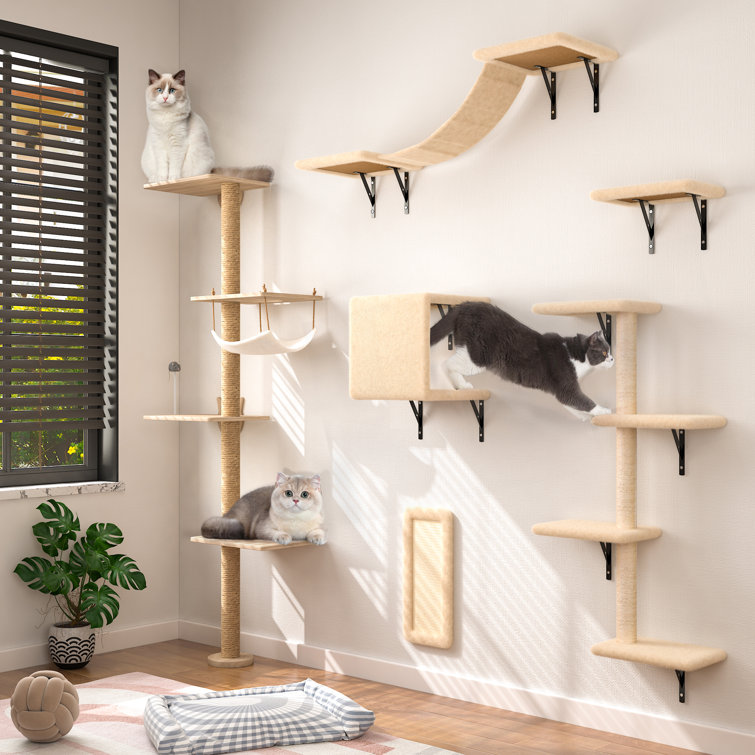
Credit: www.wayfair.com
Selecting The Right Cat Tree
Is your feline friend’s playtime marred by a shaky cat tree? A stable base for your cat to leap, climb, and nap is crucial. Let’s dive into how to pick a steadfast cat tree that ensures safety and endless enjoyment.
Key Features Of A Stable Cat Tree
A cat tree should endure through wild cat antics. Stability is paramount. Here are must-have features:
- Wide Base: A broad base anchors the tree firmly.
- Heavy Frame: Weighty structures wobble less.
- Low Center of Gravity: Keeps the cat tree upright during enthusiastic play.
- Multilevel Design: Offers balance with platforms at varying heights.
Material Matters: Wood Vs. Carpet
Material choices influence your cat tree’s stability. Explore wood and carpet options:
| Wood | Carpet |
|---|---|
| Offers rigid support | Provides grip for paws |
| Durable against scratching | Encourages clawing activity |
| Heavier base for stability | Softens landings from jumps |
Picking the right materials means less shaking, more playing. Wood-based cat trees often stand the test of time and feisty feline frolics.
Placement Tactics For Stability
Ensuring your cat tree stands firm is essential for your feline’s safety and your peace of mind. A stable cat tree provides a secure area for play and rest. The right placement tactics can prevent wobbles and shakes. Let’s explore the prime areas in your home and how to ensure level ground for optimal cat tree stability.
Prime Locations At Home
Finding the perfect spot for a cat tree involves considering traffic flow, wall support, and space. Choose a location that cats naturally gravitate towards.
- Corners are excellent for stability, as they provide support on two sides.
- Alongside furniture that is less likely to move adds extra steadiness.
- Avoid high-traffic areas to reduce the risk of it being knocked over.
- Ensure enough space around for your cat to jump on and off with ease.
Pro Tips For Level Ground
A level base is key to a non-wobbly cat tree. Start by checking the ground where you want to place it.
- Use a level tool to check flatness of the floor.
- If on carpet, press down around the base to compact any soft spots.
- For uneven floors, consider adjustable feet or a wedge under the base.
- Secure loose parts with proper fittings for added firmness.
Regular checks and adjustments will keep the setup ideal for your cat’s safety.
Securing The Base
Is your cat tree shaking like a leaf every time your kitty leaps onto it? Fear not! Securing the base can turn that wobbly cat tree into a steadfast tower. Let’s make sure that your feline’s favorite lookout spot remains safe and stable.
Enhancing Base Weight
A heavy base equals a stable tree. Consider these simple steps to add heft to the base:
- Use Sandbags: Place them evenly around the bottom.
- Anchor with Books: Stack sturdy books on or around the base platform.
- Add Gym Weights: Rubber-coated weights fit perfectly without damaging floors.
Diy Solutions For A Solid Foundation
DIY enthusiasts, unite! Custom solutions can fix that wobble. Try these tricks:
- Non-slip Mats: Lay them under the base to prevent sliding.
- Wooden Board: Secure a larger plywood board to expand and stabilize the base.
- Corner Bracing: Attach small metal brackets where the base meets the uprights for extra strength.
Incorporate these tips and enjoy a serene, wobble-free environment for your cat’s adventures!
Wall Anchoring Techniques
Cats love their perches high and mighty, but a wobbling cat tree can send your feline friend’s confidence—and safety—toppling. Sturdy support isn’t just comforting; it’s critical. Wall anchoring techniques offer a secure solution. They fix your cat’s tree firmly in place, ensuring every jump or scratch remains a worry-free delight for both you and your pet.
Choosing The Right Anchors
Not all anchors are created equal, and choosing the right ones is a pivotal first step. Consider the wall type: Drywall asks for a different approach compared to concrete or wood stud walls.
- Drywall: Use toggle or molly bolts for robust support.
- Concrete or Brick: Go for sleeve anchors or concrete screws.
- Studs: Secure it directly using wood screws.
Always select anchors that can support the combined weight of the cat tree and your feline. Check the packaging for weight limits to ensure optimal safety.
Step-by-step Anchoring Guide
With the right anchors in hand, a secure cat tree is just steps away. Follow this guide:
- Position the cat tree against the wall where you wish to anchor it.
- Identify the height at which you will attach the supports.
- Use a stud finder for walls with studs or mark your spot on drywall.
- Measure and mark the attachment points on the cat tree.
- Drill pilot holes in the wall and on the cat tree, if necessary.
- Hold the bracket against the tree and wall, then mark screw spots through the bracket holes.
- Securely fasten the anchor bolts or screws into the wall.
- Align the cat tree with the wall anchors and attach using the bracket and screws.
Enlist a friend to help if the cat tree is particularly bulky or unwieldy. A firm, snug fit is what you’re aiming for, so tighten the attachments just right.
| Type of Wall | Type of Anchor | Tool Needed |
|---|---|---|
| Drywall | Toggle/Molly Bolts | Drill |
| Concrete/Brick | Sleeve Anchors/Concrete Screws | Hammer Drill |
| Studs | Wood Screws | Stud Finder (optional) |
Double-check all connections once complete. Give the cat tree a gentle shake to test stability. No more wobbles? Mission accomplished.
Regular Maintenance Checks
Keeping your cat tree stable is vital for your furry friend’s safety. Cats love to climb and lounge on their trees. A shaky cat tree can scare your pet or worse, cause an injury. Perform regular maintenance checks to ensure it stays secure. Regular checks are easy but crucial for a sturdy cat tree.
Inspect And Tighten
Time can loosen the nuts and bolts on your cat tree. Begin periodic inspections with these steps:
- Look for loose parts: Check each component of the cat tree.
- Identify wobbly sections: Notice any movement in areas that should stay fixed.
- Use the right tools: A simple screwdriver or wrench can tighten most parts.
- Check all fasteners: Ensure screws, nuts, and bolts are snug, not over-tightened.
Make these inspections a regular habit. Do it monthly or whenever you spot your cat tree shaking.
When To Replace Parts
Understand when parts need replacing, not just tightening. Here’s what to consider:
- Worn-out parts: Look for signs of wear like splintering wood or frayed ropes.
- Broken pieces: Replace immediately to prevent hazards.
- Missing elements: Sometimes parts get lost over time. Find the right replacements.
Manufacturers often sell spare parts. Contact them or visit their website. Measure broken parts to get the perfect fit. Keep your pet safe and happy with these simple steps.
| Check | Frequency | Notes |
|---|---|---|
| Tightening bolts | Monthly | Use correct tools |
| Inspecting parts | Monthly | Look for wear and tear |
| Replacing parts | As needed | Measure for accuracy |
:strip_icc()/best-cat-trees-4159408-da66af890782426fb82e6036af07b36b.jpg)
Credit: www.thesprucepets.com
Frequently Asked Questions For How To Stop Cat Tree From Wobbling
Why Does My Cat Tree Wobble?
Cat trees can wobble due to uneven flooring, loose bolts, or weight imbalances. Ensuring it is on a flat surface, properly assembled, and evenly weighted can mitigate wobbling.
How Can I Stabilize A Shaky Cat Tree?
To stabilize a shaky cat tree, tighten all screws and bolts. If needed, add non-slip pads beneath it. For extra stability, consider anchoring it to a wall or the ceiling.
What Materials Help Fix A Wobbly Cat Tree?
Non-slip pads, wall anchors, or additional wood supports can fix a wobbly cat tree. Ensure the materials adhere well to the tree and the floor to improve stability.
Can Moving A Cat Tree Stop It From Wobbling?
Moving a cat tree to a more level, stable surface can help stop it from wobbling. Avoid placing it on carpets or uneven tiles, as these surfaces can contribute to instability.
Conclusion
Securing your feline friend’s play haven is straightforward with the right approach. Remember, stability is key for your cat’s safety and peace of mind. Address loose bolts, consider the base, and embrace wall anchors when necessary. Your cat’s tree should now stand unwavering, awaiting their adventurous spirits.
Give your beloved pet the gift of a sturdy paradise today!
